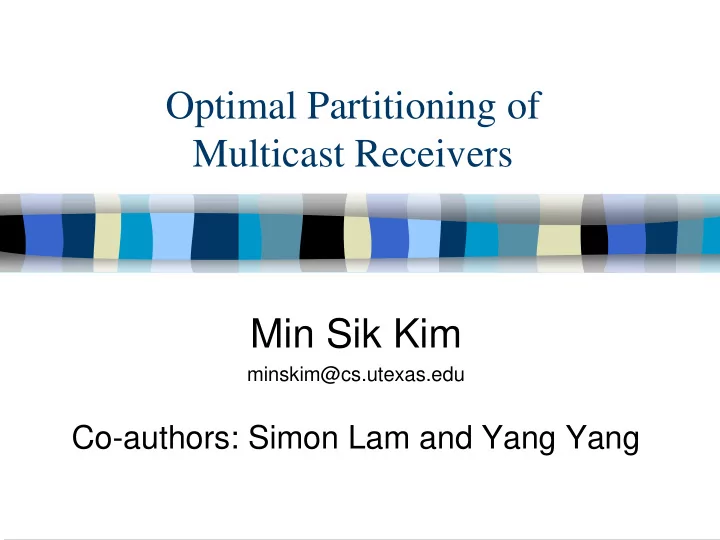

Optimal Partitioning of Multicast Receivers Min Sik Kim minskim@cs.utexas.edu Co-authors: Simon Lam and Yang Yang
Outline of Presentation � Motivation � Optimal Receiver Partitioning � Max-min Fair Rate Optimal Partitioning � Experimental Evaluations � Conclusion
Why Optimal Partition? � Heterogeneous receiver capacities – Receiver host restrictions – Network path: Modem, ISDN, Cable Modem, LAN Sender R1 R2 R3
How to determine the sending rate(s)? Sender Sender � Single-rate s s o – The lowest rate L – To maximize R1 R2 R3 R1 R2 R3 inter-receiver fairness Sender � Multi-rate – Q1: How many groups? R1 R2 R3 – Q2: How to determine the rates?
Q1: How many groups? � As many as receivers � A fixed number of groups, e.g., 4 groups � The more groups, the higher – the sender overhead to encode – the network overhead to keep the states – the receiver overhead to decode � Our result: 4-5 groups for majority of benefits
Q2: How to determine the rates? � Static – Independent of receiver capacities – Determined by encoding scheme � Dynamic 1. Heuristics 2. Our solution: dynamic programming to find an optimal solution
Answer to Q2: Optimal Receiver Partition Sender � Terminology g = 1 – Isolated rate r i – Receiver utility function u ( r, g ) R1 R2 R3 – Group utility r i 1 3 2 u ( r i , g ) 1.0 0.3 0.5 = U ( G , g ) u ( r i g , ) ∑ ∈ U ( G , g ) = 1.0 + 0.5 + 0.3 = 1.8 i G
Receiver Utility Function � u ( r, g ) � Properties – Non-decreasing when r and g approach to each other. – Maximum when r = g. � Examples u u r g r g u ( r , g ) = min( r , g ) u ( r , g ) = min( r , g ) / max( r , g )
Optimal Partition Sender g 1 = 1 g 2 = 2 � Session utility ({( , ), , ( , )}) V G g G g � R1 R2 R3 1 1 K K r i 1 3 2 K = U ( G , g ) u ( r i , g 1 ) 1.0 ∑ k k = u ( r i , g 2 ) k 1 0.7 1.0 U ( G 1 , g 1 ) = 1.0 U ( G 2 , g 2 ) = 1.0 + 0.7 = 1.7 V = 1.0 + 1.7 = 2.7 � Optimal partition – Maximizes the session utility.
Finding the Optimal Partition � Ordered partition r ≤ i ∈ ∈ – If and , then . r G j G + i j k k 1 r 1 r 2 r 3 r 4 r 5 r 1 r 2 r 3 r 4 r 5 Ordered partition Unordered partition � There exists an ordered partition that is optimal. r 1 r 2 r 3 r 4 r 5 r 1 r 2 r 3 r 4 r 5 r 1 r 2 r 3 r 4 r 5 r 1 r 2 r 3 r 4 r 5
Finding the Optimal Partition � Dynamic programming algorithm – Finds the ordered optimal partition ( ) = − + + * * * V ( i , m ) V ( j , m 1 ) U ({ j 1 , , i }) max � ≤ < 1 j i r 1 r 2 … r j … r i m- 1 groups m -th group − * + V ( j , m 1 ) * U ({ j 1 , , i }) �
Answer to Q1: Number of Groups u ( r , g ) = min( r , g ) u ( r , g ) = min( r , g ) / max( r , g ) 100 100 80 80 Utility (%) Utility (%) 60 60 40 40 Uniform Uniform Normal Normal 20 20 Bi-modal Bi-modal 0 0 1 2 3 4 5 6 7 8 9 1 2 3 4 5 6 7 8 9 The number of groups The number of groups � 4 groups for 80% of the maximum.
Collecting Isolated Rates � Max-min fair rates as isolated rates � Aggregation [1, 4): 2 [4, 7]: 3 [4, 5.5): 1 [1, 3): 2 [5.5, 7]: 1 [3, 5]: 1 1 2 5 4 7
Experimental Evaluations u ( r , g ) = min( r , g ) u ( r , g ) = min( r , g ) / max( r , g ) 162 825 820 160 815 810 Normal 158 805 V V 800 156 795 790 154 785 152 780 1 2 3 4 5 6 7 8 9 10 1 2 3 4 5 6 7 8 9 10 The number of intervals The number of intervals 1050 168 1040 166 1030 164 Bi-modal V V 1020 162 1010 160 1000 158 156 990 1 2 3 4 5 6 7 8 9 10 1 2 3 4 5 6 7 8 9 10 The number of intervals The number of intervals � Aggregation error < 3% with 4 intervals.
Conclusion � Heterogeneous receiver capacities. � Determine the optimal receiver partition in multi-rate multicasts. � Achieve 80% of the maximal utility. � Future work – Extension to other network fairness.
The End Question?
Recommend
More recommend